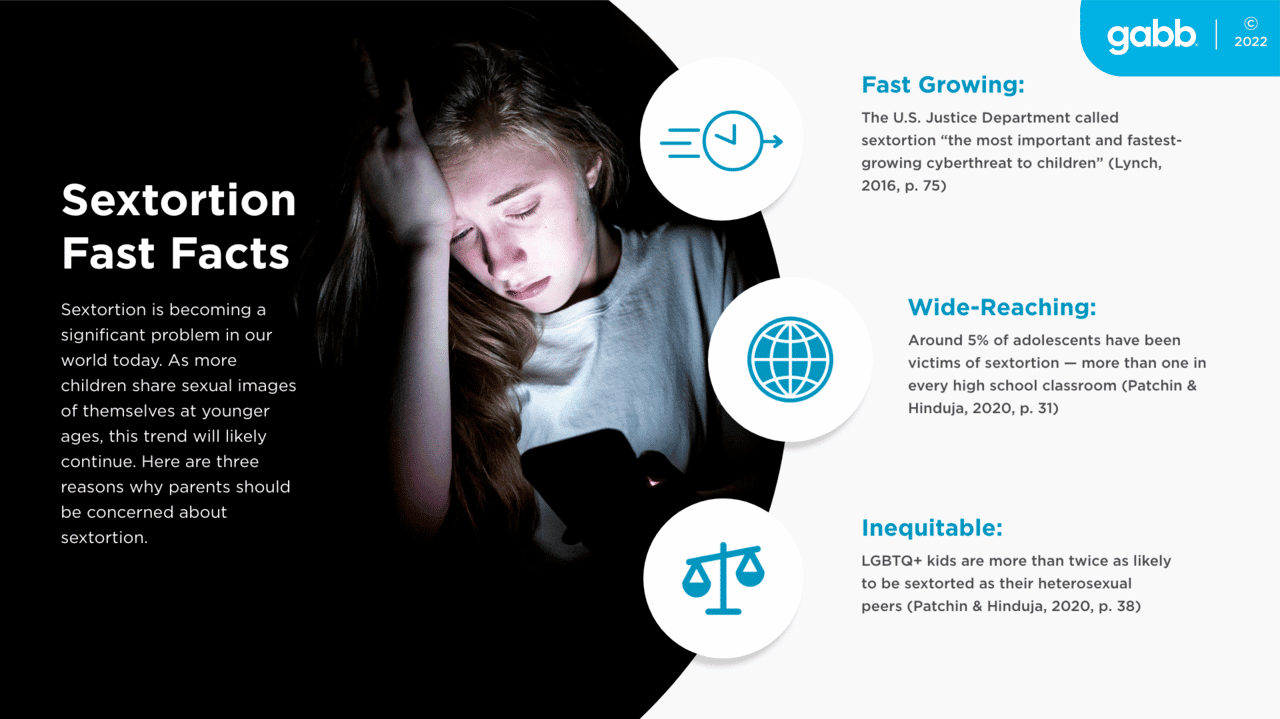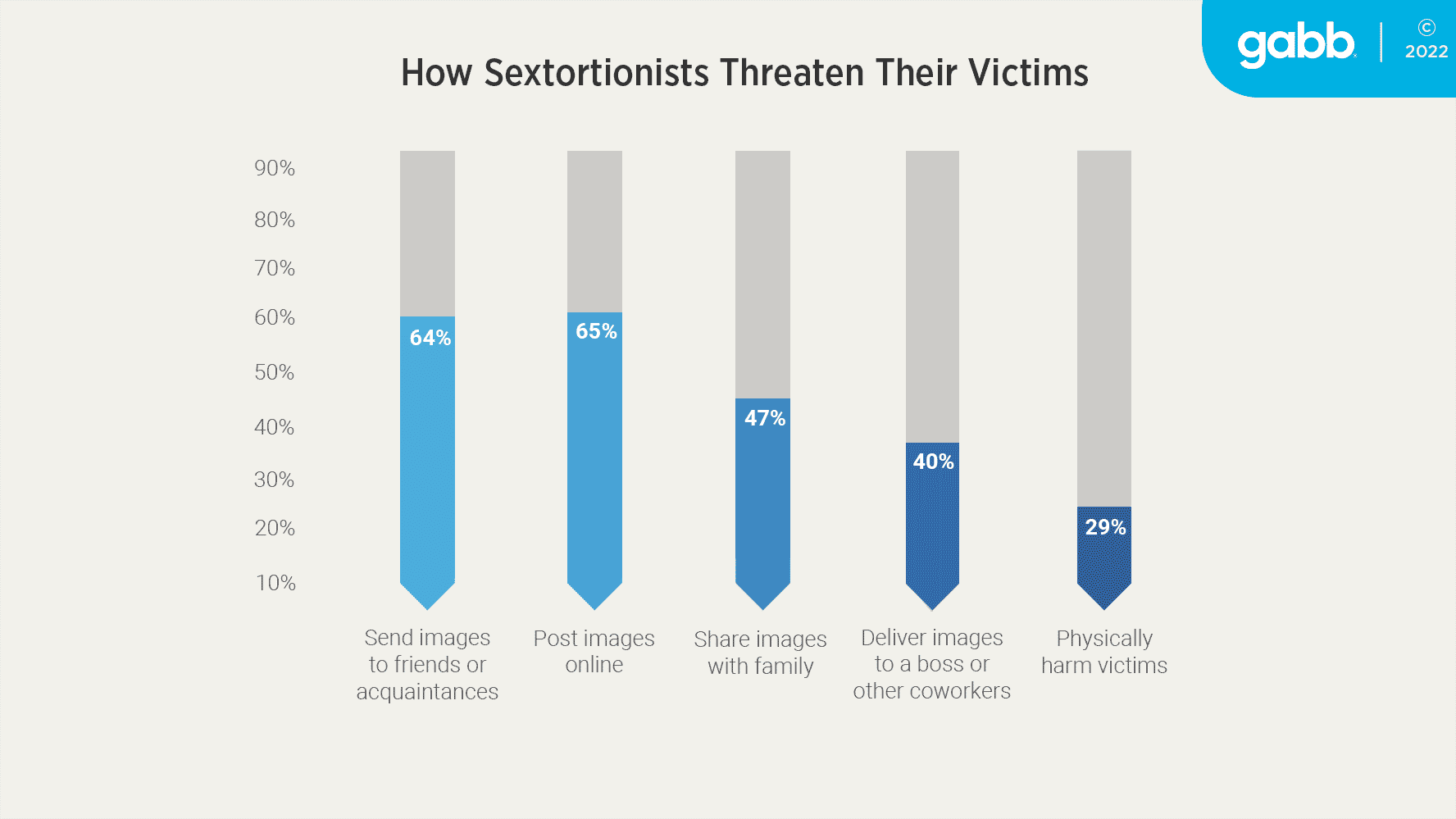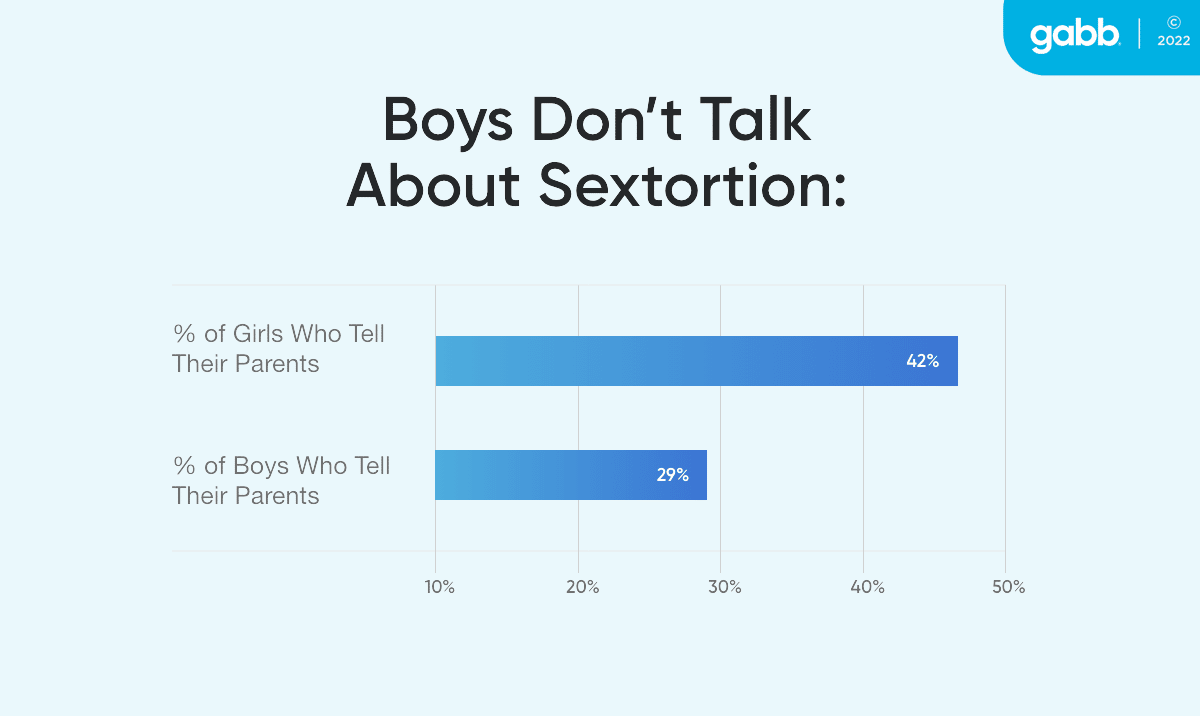Globally, sextortion has become a serious threat to young people. Despite its increasing frequency, parents have the power to protect and teach their children to navigate the digital landscape safely. By being aware of the issue and involved in their digital lives, we can help keep our families safe.
Even if your child has been victimized, by being a safe place for them to tell their story, you can prevent more abuse and help them to heal.
Sextortion Meaning
Sextortion is a play on words that describes sexual extortion—an extremely serious crime where the perpetrator uses threats to obtain sexual favors, sexually explicit imagery, or money (Federal Bureau of Investigation). 1
An abuser often attempts to intimidate their victims by threatening to send sexual images or videos to friends and family, post them online, cause trouble at work or school, or physically harm them. 12
Sexting Is Common Among Youth
Researchers reviewing a large data sample found that “19% of teens had sent a sext, 35% had received one and 15% had forwarded one without consent.” 15 Other studies put the number at 1 in 4 teens engage in sexting with 1 in 12 forwarding nude images received to others without the sender’s consent. 16
Sextortion Examples
Adolescent sextortion typically falls into one of two categories: internet (online) sextortion or offline sextortion.
Internet sextortion
Internet sextortion occurs when a perpetrator engages in harassment online. It is common for the perpetrator to be a stranger.
Abusers often form relationships with their victims through grooming, but they can also use scams to obtain compromising images for blackmail. 12 Sexual predators typically operate using multiple online accounts and target victims in multiple states and countries.
Facebook, Instagram, Roblox, and VRChat all provide opportunities for offenders to abuse children. [11]
This exploitation can take place on virtually any platform that allows for communication. Sextortion online is possible when a social network allows users to share photos or videos, or even just a chat function. 1
Most sextortion incidents do not occur . . . through secret recordings, hacking, or the stealing of images and video. Instead, targets tend to voluntarily provide the images.
—Dr. Justin W. Patchin, Associate Professor of Criminal Justice Program, University of Wisconsin-Eau Claire
Offline sextortion
Offline sextortion is particularly dangerous because those involved may not realize their relationship isn’t healthy or that they are engaged in sextortion. 12
Despite less media attention, dating sextortion is more common. In 59% of sextortion cases, the victim knew the perpetrator in person and had a relationship with them when images were shared. 7
Online and offline sextortion
These two categories—online and offline sextortion—aren’t mutually exclusive, and the line between them can be blurred or nonexistent.
For instance, a perpetrator might meet a child online and form a connection with them. The child might believe they’re in a real relationship and willingly provide sexual images, not realizing the perpetrator is involved in dozens, even hundreds, of such “relationships”. 12

Digital permanency—postings are forever
Despite misgivings, many young people acquiesce because they trust their partner or don’t want to damage the relationship. 7 People often rationalize that sending pictures to one person won’t hurt, not realizing the permanency of digital images—that once sent, they can live forever online.
Even if the photos don’t resurface, they continue living on the platform. In 2014, for instance, 98,000 Snapchat photos were leaked by hackers. There is never a guarantee your private photos can’t become public.
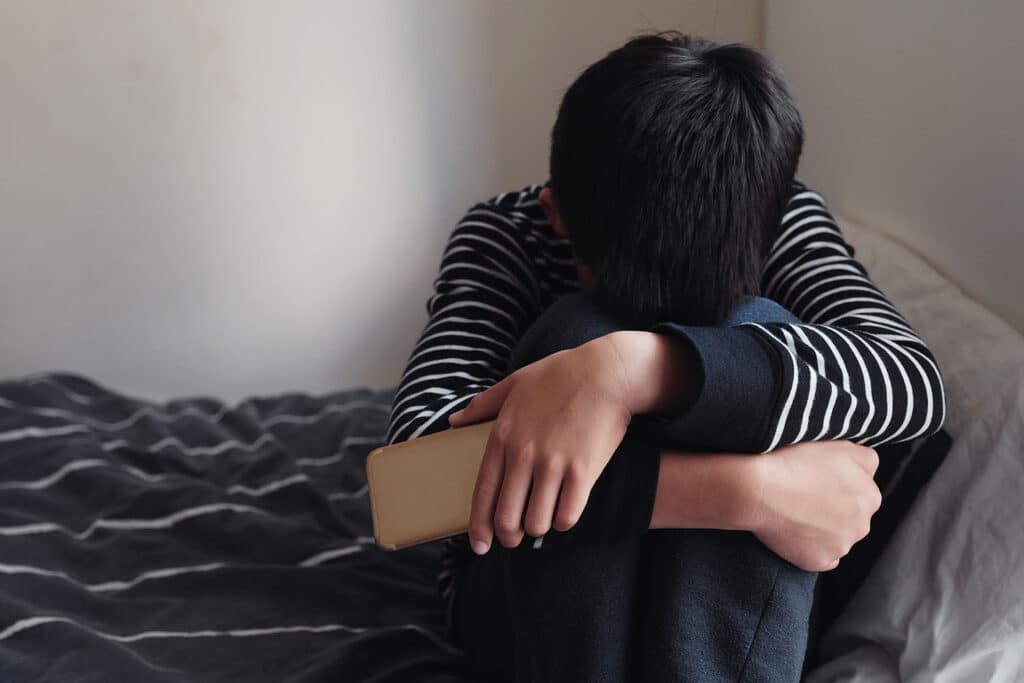
Sextortion of Children and Adolescents
Sextortion is a serious crime under any circumstance, but it is especially sinister when the victims are children.
Adolescents are more susceptible to sextortion because of their developmental stage. They take more risks, struggle to control their impulses and desires, and are more easily swayed by peer pressure. 7
Abusers take advantage of this. Child sextortion is becoming increasingly common—the U.S. Justice Department identified it as “the most important and fastest-growing cyberthreat to children”. 5

Rise in Sextortion of Boys
While girls are more likely to experience dating violence and other forms of sexual abuse, sextortion also hurts boys. 12, 14
However, boys are significantly less likely to tell their parents they are victims of sextortion than girls. The FBI has recently warned parents of a dramatic increase in sextortion of young men over the past year. 3, 4
Predators pose as false personas
Predators targeting boys often pose as girls the same age as their targets or slightly older. They will send sexual content depicting the girls they are pretending to be and then ask the boys to reciprocate. They might also use their persona to manipulate the young men into sexually explicit activities through video chat, which they secretly record.

Perpetrators will then threaten to release the compromising images to get their victims to send more money, additional images, or perform other sexual acts. 4
Parents of boys, and the boys themselves, need to be aware that sextortion isn’t simply a crime against girls. Without this understanding, they will be less likely to recognize dangerous situations as they come.

Sextortion Against LGBTQ+ Youth
Young people in the LGBTQ+ community are at greater risk for sextortion. Research suggests this might be because these kids rely more on online communities for social support than their heterosexual and gender conforming peers. 10
LGBTQ+ teens are more than twice as likely to be victims of sextortion as their heterosexual and gender conforming peers.
This reliance is a key factor that has led 37% of LGBTQ+ minors to continue talking to someone online even after they were made to feel uncomfortable. 10 Greater and consistent social support from family members and friends can create safety barriers for those most at risk.

Negative Effects of Sextortion on Adolescents
Sextortion victims are much more likely to experience health problems than non-victims. These negative impacts can last into adulthood.
In one longitudinal study, girls who had been abused by significant others were more likely to experience depression as they grew into adulthood and to smoke and abuse alcohol. 12
Similarly, victimized boys were more prone to have antisocial behaviors and to use marijuana. 12
As a whole, one in four victims use mental health support and report suicidal ideation more often than non-victims. 12

Why Kids Hide Being a Victim of Sextortion
Experts say that speaking to a trusted adult is among the most important steps children can take to escape and recover from sextortion. Unfortunately, most kids aren’t doing this.
Nearly half of girls (41.7%) and even fewer boys (28.6%) who endure sextortion tell their parents. 7
While some of these juveniles will tell a different authority figure or at least a friend, 49% don’t tell anyone. 11
49% of sextortion
victims never
tell anyone.
There are several reasons for this. Most children who keep sextortion a secret are too embarrassed to ask for help (81%), while 68% are afraid of getting in trouble if they tell.
Nearly half believe they can handle sextortion independently, while 26% fear adults can’t help them. 12
Some children are simply afraid to talk with their parents. They rationalize that minimizing the incident will solve the problem, not realizing that the perpetrator is unlikely to leave them alone or that the situation is likely to escalate. 7
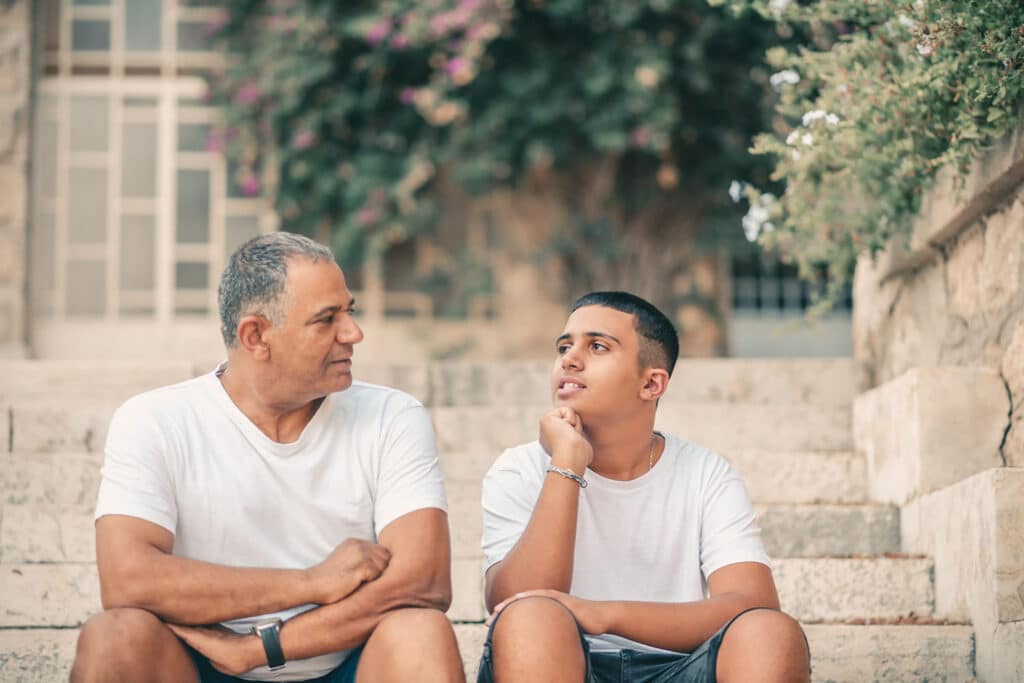
Encouraging Open Communication
Consider the following ideas to help create a comfortable environment where kids can freely talk about sextortion.
Talking about sexting
As parents, we can find out how our children feel and what they think about sexting by asking questions.
- How much sexting do you think is happening at your school? Do kids talk about it?
- What do teachers and administrators say about it?
- What do you think about sexting? Why do you think kids do this? What questions do you have about sexting?
- Have you heard or seen instances where kids have shared nude photos they received from others?
- Do you know you can always talk to me if you find yourself mixed up in this?
Kids need a safe place to talk about sexting and sextortion
It would be completely understandable to have a visceral reaction if we were to find that our child has been sexting or is a victim of sextortion. When parents can remain calm, it is more likely that kids will come to us when they are in trouble.
Did you know you can always come to me, even if you have sexted someone?
Each suggestion addresses a key reason young people keep instances of sextortion a secret.
Overcoming Kids’ Fears about Telling an Adult
- Talk About Sex – Children feel less embarrassed when parents talk about healthy sexuality with them frequently and regularly. Curiosity about sex is natural. Encourage children to ask questions.
- Show Unconditional Love and Support – While parents can insist that adolescents never take or share sexual images of themselves, stress that your teens will always be loved and supported no matter what.
- Model How to Ask for Help – There is nothing wrong with asking for help, and parents can be powerful examples of this. If appropriate, be transparent about your own personal struggles. Let them share some advice with you regarding work or skills they can help you learn.
- Communicate How You Can Help – Become informed about how to support victims of grooming and abuse. As part of your conversations about sextortion, describe exactly what you would do if a young person approached you for help.
Another great way to start a conversation is to read Four Common Questions About Sextortion with your child.
This article answers common questions, helps kids know they are never alone, and provides them with direction if they find themselves in a bad situation.
How to Prevent Sextortion
Kids can be empowered when they are taught how to recognize the threat of sextortion. Here are some suggestions to help parents keep their children safe.
Understand the dangers of sexting
Regardless of whether they are in a relationship, parents can teach their children about the dangers of sexting. Share with them that in 57% of sextortion incidents involving boys and 49% involving girls the perpetrator was a romantic partner or friend. Discuss how emojis can be used inappropriately and that predators use these symbols to establish trust and to hide their true intent from parents.
26% of youth in dating relationships have suffered some type of cyberdating abuse.
Furthermore, one study found that in 2020, 26% of youth involved in dating relationships suffered through cyberdating abuse. 7
Besides being dangerous, sharing sexually explicit photos is also illegal. Whether the images are of your child or were only shared with other minors, in some states exchanging sexual images of children can be considered child pornography distribution. 9
Learn about sextortion scams
Parents and teens can also protect themselves by learning about sextortion scams.
Teach digital media literacy
Helping children develop digital media literacy skills can serve them well. Young people who understand digital permanency, who can recognize unreliable websites, and who know how to appropriately communicate online are less likely to be duped by online sextortionists.
Children with strong digital media literacy skills understand that predators can pretend to be anyone online.
Help kids understand that photos and videos are no longer sufficient to prove the identity of an online user. 4 All predators are tricksters.

Engage in frequent communication
The best defense against sextortion is frequent communication that is open and honest. 2 Sextortion, like all forms of sexual abuse, thrives in secrecy. Strong parent-child relationships combat this.
Information-sharing and open lines of communication are the best defense.
—Federal Bureau of Investigation
In conversations, parents can spot potential problems early on, offer support before issues escalate, and empower children to learn how to safely navigate the digital world.
We can provide a safe place to ask for help by having regular conversations about online safety and times we have gotten ourselves into dangerous situations. Kids will feel safer coming to us if they know we are flawed and have made many mistakes.
Parents can assure children that even if they have made a big mistake, they can always talk to mom or dad to get help.
7 Bs to combat sextortion
The 7Bs to combat sextortion will help your child fight against the abuse. Share these seven principles with your child so that they won’t fall victim to online and offline sextortion.
Safe tech
Even responsible children may be manipulated into providing sexually explicit images by sextortionists. Modern technology can benefit families while avoiding risks at the same time. Safe tech is often the answer.
Devices without internet and social media access can teach kids essential digital media literacy skills, allow families to stay connected throughout the day, and keep them safe from online predators.

Take a look at these conversation starters when you decide to discuss sextortion with your children.
Conversation Starters about Sextortion
- Have you ever heard of sextortion? What do you know about it?
- In today’s digital age, do you think it is a big deal?
- Why do you think teenagers sext, especially if they aren’t comfortable with it?
- Have any of your friends ever done this?
- Has anyone ever asked you for sexual pictures? How did you respond?
- How would you respond if you were being asked to sext?
- How do you imagine I’d respond if you came to me for help?
Although sextortion is becoming increasingly prevalent, we can take action to protect our children and empower them to protect themselves. Following these suggestions can help keep everyone aware and capable.


